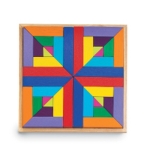Back to school means back to homework, activities, and hectic schedules. It is hard to carve out time out of busy  schedules to just wind-down with your kids and simply enjoy each other’s company.
schedules to just wind-down with your kids and simply enjoy each other’s company.
Puzzles can be a great avenue for spending quality time with your children while helping them develop psychologically, emotionally, physically and academically. You would be amazed at what you can learn about your child while working with him and observing him as he completes a puzzle – the way he approaches and solves problems (does he get frustrated or does he keep searching for the right piece?), fine motor development (can he easily fit the pieces together or is it a challenge?), etc. With younger children, it is easier to sit down with them for 10-15 minutes to work a puzzle. However, older children may require more time. Even if you don’t have 30 minutes or more to spare on some of the more complicated puzzles, you can designate a special spot in your house for puzzles where you can leave it and come back to it when you have time. You might also be surprised to see your child gravitate to the puzzle without you on occasion, as she learns perseverance and the wonderful feeling of accomplishment when the puzzle is completed.
According to the Child Development Institute, there are so many reasons why puzzles are important to the development of your child.
- Hand-eye coordination
- Manipulating the world around him/her
- Developing fine motor skills
- Developing gross motor skills for younger kids through stacking blocks and larger puzzles
- Problem solving
- Shape recognition
- Memory
- Setting small goals
- Achieving a goal and increasing self-confidence
You can also use puzzles to encourage learning and creativity. For instance, if you are constructing a puzzle such as the  Melissa & Doug’s Rainforest Puzzle with your preschooler, you can talk about the different animals that you might find in a rainforest and create a story using these animals as characters. You can also try to recreate the animals on paper using the puzzle as a guide to further enhance their fine motor skills and hand-eye coordination.
Melissa & Doug’s Rainforest Puzzle with your preschooler, you can talk about the different animals that you might find in a rainforest and create a story using these animals as characters. You can also try to recreate the animals on paper using the puzzle as a guide to further enhance their fine motor skills and hand-eye coordination.
 A great puzzle to do with all ages (ages 3 and up), although it’s not your traditional puzzle, is Pattern Play by Mindware. This set comes with pattern cards where the child has to figure out how to recreate the pattern using the multi-shaped and multi-colored pieces. Or, for younger children (ages 3-4), they can create their own patterns by fitting the pieces together on the board. This is a wonderful set to leave out on a table – my kids always gravitated toward this set when I left it out and recreated one pattern at a time.
A great puzzle to do with all ages (ages 3 and up), although it’s not your traditional puzzle, is Pattern Play by Mindware. This set comes with pattern cards where the child has to figure out how to recreate the pattern using the multi-shaped and multi-colored pieces. Or, for younger children (ages 3-4), they can create their own patterns by fitting the pieces together on the board. This is a wonderful set to leave out on a table – my kids always gravitated toward this set when I left it out and recreated one pattern at a time.
Rotate your puzzles often to keep kids interested and engaged while bonding with their favorite person – you!
About the Author
Shannon McAfee is a mom of three girls in Glen Allen, VA. She is the Founder and Owner of TOYconomy, an online toy rental service for children. She is a huge advocate of play to enhance child development and strengthen the bonds and communication with children.
Filed under: Articles and updates, TOYplay Tips | Tagged: child development, educational activities for kids, gross motor skills, hand eye coordination, melissa & doug, Mindware, puzzle play, puzzles for kids, recognition memory, shape recognition | Leave a comment »




